Boeing Company: Raw Material Supply Chain Risk Mitigation Analysis
VerifiedAdded on 2022/08/27
|11
|2356
|20
Report
AI Summary
This report analyzes the raw material supply chain risk mitigation strategies of the Boeing company. It begins with an executive summary and table of contents, followed by an introduction that highlights the importance of raw materials to modern manufacturing and the associated supply chain risks. The report identifies the problems Boeing faces due to limited raw material availability, the mechanisms driving these risks, and methods for measuring the company's vulnerability. It details current problems, such as increasing raw material levels and simplistic risk management approaches, and proposes a SMART risk management approach with specific, measurable, actionable, realistic, and time-phased strategies. An implementation strategy, including aligning with organizational values and creating a detailed plan, is also outlined. Finally, the report suggests a total quality management improvement plan to ensure successful implementation and monitoring of the proposed strategies. The report concludes by emphasizing the importance of proactive risk management for Boeing's long-term success and provides recommendations for improving the company's supply chain resilience.
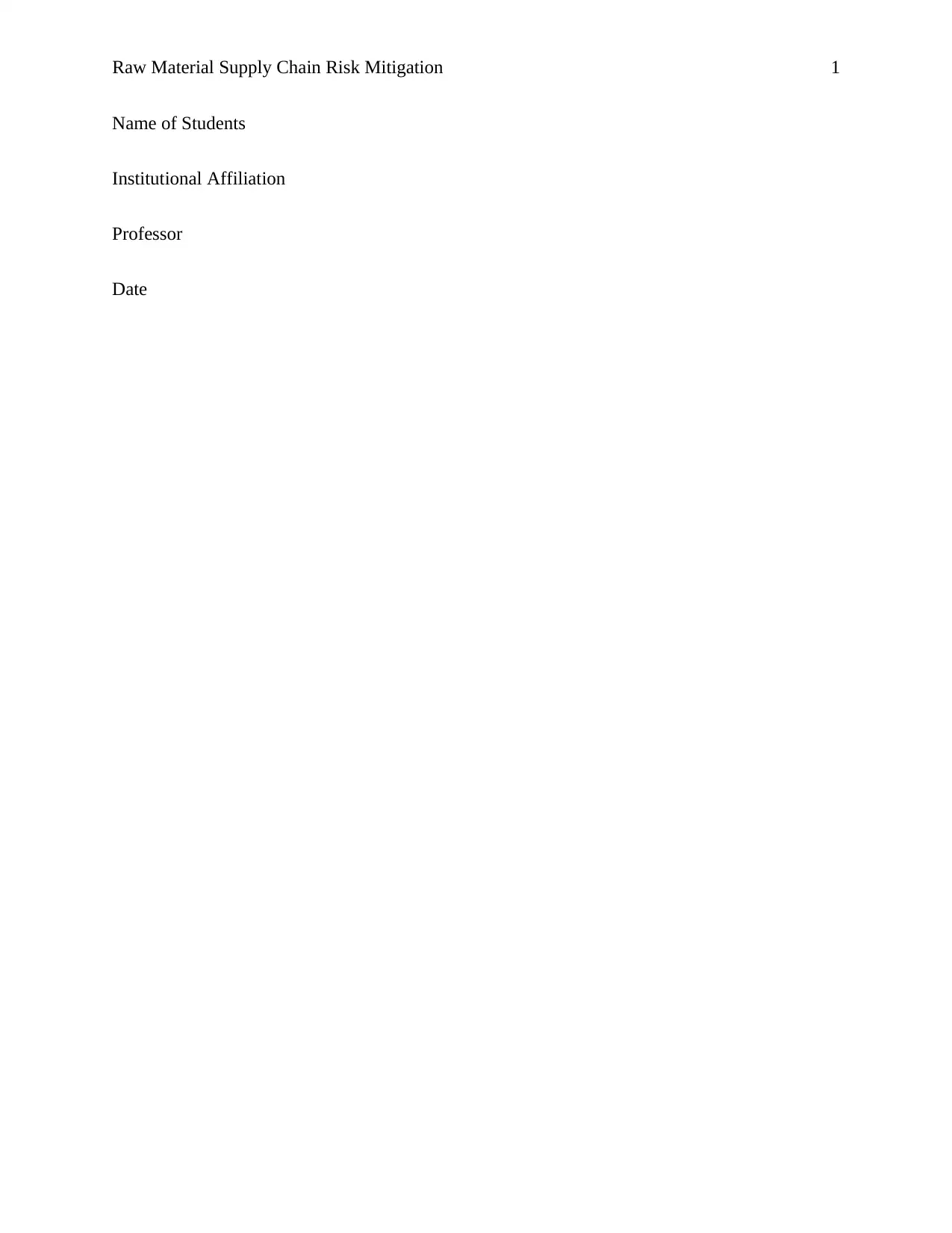
Raw Material Supply Chain Risk Mitigation 1
Name of Students
Institutional Affiliation
Professor
Date
Name of Students
Institutional Affiliation
Professor
Date
Paraphrase This Document
Need a fresh take? Get an instant paraphrase of this document with our AI Paraphraser

Raw Material Supply Chain Risk Mitigation 2
Executive summary
Some of the approaches used in identifying various challenges faced by the management of the
Boeing company in addressing material supply chain risk mitigation and the necessary strategies
required to address the issues are resolved. The paper focuses on identifying three types of
problems that the company is facing, how they are currently managing, and the most efficient
strategies required to address them are proposed. The risks that are related to critical material
supply can be addressed in various ways by adopting new supply chain processes. Conversely,
the company can reduce its raw material demand levels through the development of new process
within the company to recover its manufacturing scrap and utilize the available substitutes in the
market. With full knowledge, a clear understanding and the required expertise in the raw material
mitigation processes as a way of separating the technologies and process modelling, and various
process optimization the study amply addresses the contributions needed for the management to
address the predominant issues.
Executive summary
Some of the approaches used in identifying various challenges faced by the management of the
Boeing company in addressing material supply chain risk mitigation and the necessary strategies
required to address the issues are resolved. The paper focuses on identifying three types of
problems that the company is facing, how they are currently managing, and the most efficient
strategies required to address them are proposed. The risks that are related to critical material
supply can be addressed in various ways by adopting new supply chain processes. Conversely,
the company can reduce its raw material demand levels through the development of new process
within the company to recover its manufacturing scrap and utilize the available substitutes in the
market. With full knowledge, a clear understanding and the required expertise in the raw material
mitigation processes as a way of separating the technologies and process modelling, and various
process optimization the study amply addresses the contributions needed for the management to
address the predominant issues.
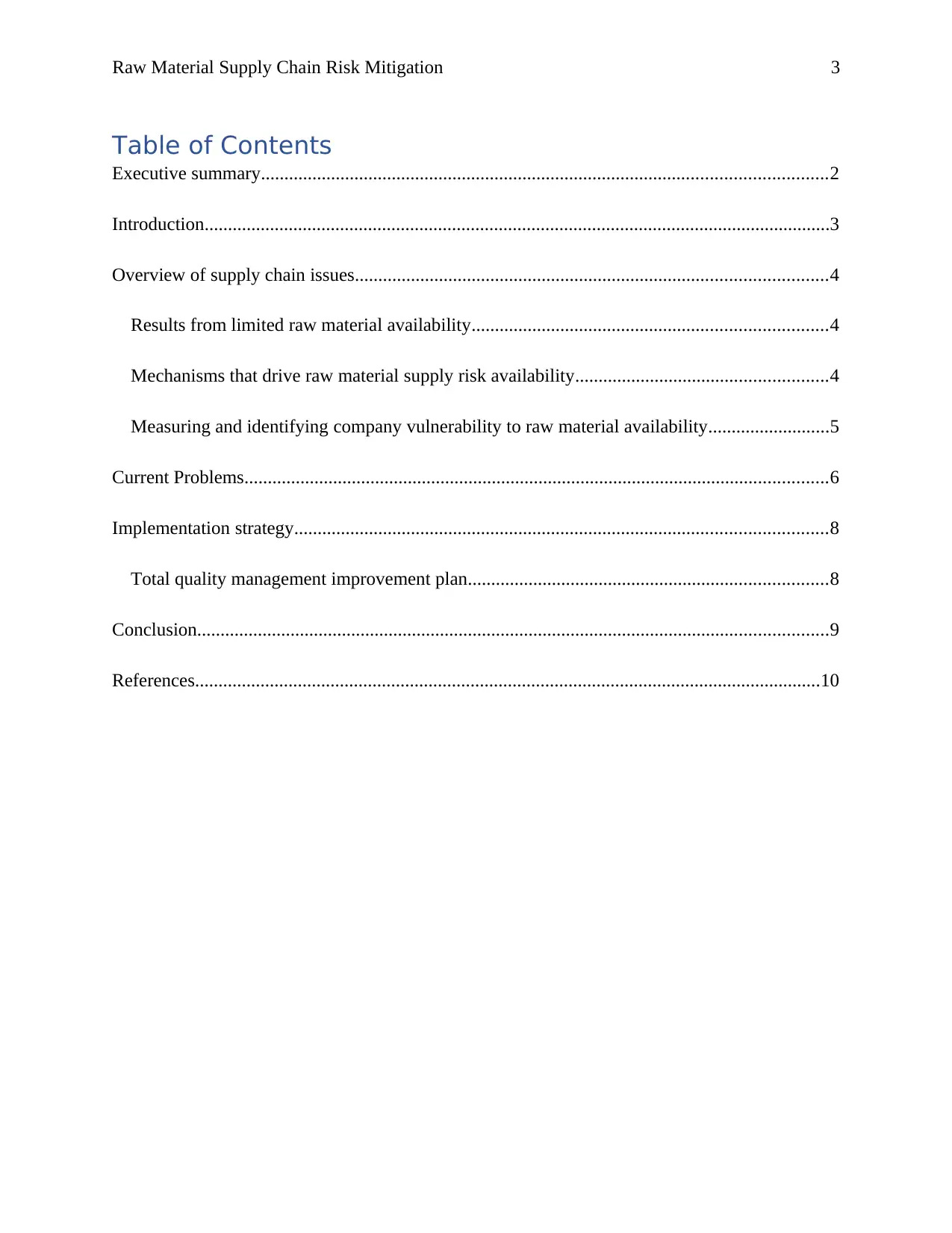
Raw Material Supply Chain Risk Mitigation 3
Table of Contents
Executive summary.........................................................................................................................2
Introduction......................................................................................................................................3
Overview of supply chain issues.....................................................................................................4
Results from limited raw material availability............................................................................4
Mechanisms that drive raw material supply risk availability......................................................4
Measuring and identifying company vulnerability to raw material availability..........................5
Current Problems.............................................................................................................................6
Implementation strategy..................................................................................................................8
Total quality management improvement plan.............................................................................8
Conclusion.......................................................................................................................................9
References......................................................................................................................................10
Table of Contents
Executive summary.........................................................................................................................2
Introduction......................................................................................................................................3
Overview of supply chain issues.....................................................................................................4
Results from limited raw material availability............................................................................4
Mechanisms that drive raw material supply risk availability......................................................4
Measuring and identifying company vulnerability to raw material availability..........................5
Current Problems.............................................................................................................................6
Implementation strategy..................................................................................................................8
Total quality management improvement plan.............................................................................8
Conclusion.......................................................................................................................................9
References......................................................................................................................................10
⊘ This is a preview!⊘
Do you want full access?
Subscribe today to unlock all pages.

Trusted by 1+ million students worldwide
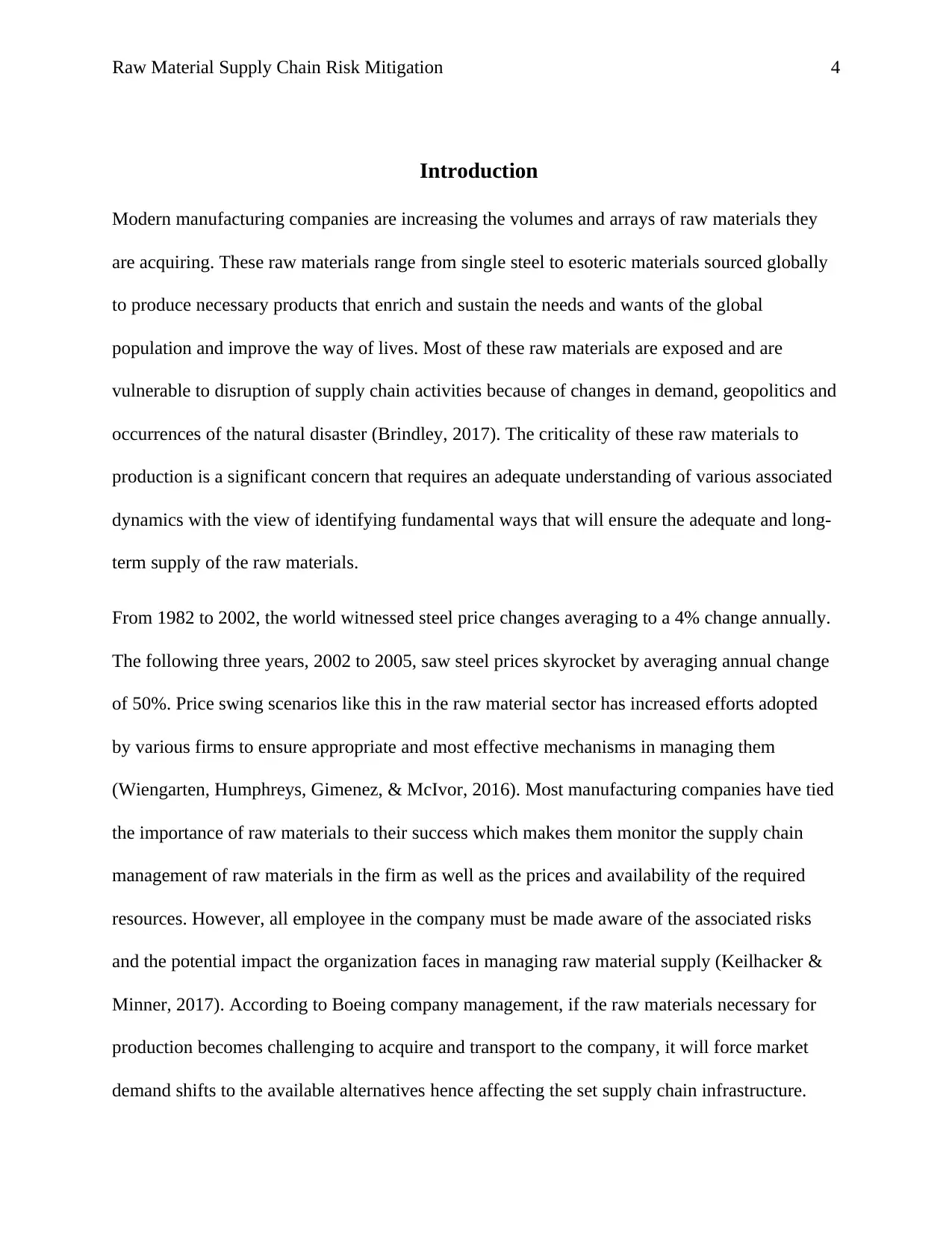
Raw Material Supply Chain Risk Mitigation 4
Introduction
Modern manufacturing companies are increasing the volumes and arrays of raw materials they
are acquiring. These raw materials range from single steel to esoteric materials sourced globally
to produce necessary products that enrich and sustain the needs and wants of the global
population and improve the way of lives. Most of these raw materials are exposed and are
vulnerable to disruption of supply chain activities because of changes in demand, geopolitics and
occurrences of the natural disaster (Brindley, 2017). The criticality of these raw materials to
production is a significant concern that requires an adequate understanding of various associated
dynamics with the view of identifying fundamental ways that will ensure the adequate and long-
term supply of the raw materials.
From 1982 to 2002, the world witnessed steel price changes averaging to a 4% change annually.
The following three years, 2002 to 2005, saw steel prices skyrocket by averaging annual change
of 50%. Price swing scenarios like this in the raw material sector has increased efforts adopted
by various firms to ensure appropriate and most effective mechanisms in managing them
(Wiengarten, Humphreys, Gimenez, & McIvor, 2016). Most manufacturing companies have tied
the importance of raw materials to their success which makes them monitor the supply chain
management of raw materials in the firm as well as the prices and availability of the required
resources. However, all employee in the company must be made aware of the associated risks
and the potential impact the organization faces in managing raw material supply (Keilhacker &
Minner, 2017). According to Boeing company management, if the raw materials necessary for
production becomes challenging to acquire and transport to the company, it will force market
demand shifts to the available alternatives hence affecting the set supply chain infrastructure.
Introduction
Modern manufacturing companies are increasing the volumes and arrays of raw materials they
are acquiring. These raw materials range from single steel to esoteric materials sourced globally
to produce necessary products that enrich and sustain the needs and wants of the global
population and improve the way of lives. Most of these raw materials are exposed and are
vulnerable to disruption of supply chain activities because of changes in demand, geopolitics and
occurrences of the natural disaster (Brindley, 2017). The criticality of these raw materials to
production is a significant concern that requires an adequate understanding of various associated
dynamics with the view of identifying fundamental ways that will ensure the adequate and long-
term supply of the raw materials.
From 1982 to 2002, the world witnessed steel price changes averaging to a 4% change annually.
The following three years, 2002 to 2005, saw steel prices skyrocket by averaging annual change
of 50%. Price swing scenarios like this in the raw material sector has increased efforts adopted
by various firms to ensure appropriate and most effective mechanisms in managing them
(Wiengarten, Humphreys, Gimenez, & McIvor, 2016). Most manufacturing companies have tied
the importance of raw materials to their success which makes them monitor the supply chain
management of raw materials in the firm as well as the prices and availability of the required
resources. However, all employee in the company must be made aware of the associated risks
and the potential impact the organization faces in managing raw material supply (Keilhacker &
Minner, 2017). According to Boeing company management, if the raw materials necessary for
production becomes challenging to acquire and transport to the company, it will force market
demand shifts to the available alternatives hence affecting the set supply chain infrastructure.
Paraphrase This Document
Need a fresh take? Get an instant paraphrase of this document with our AI Paraphraser
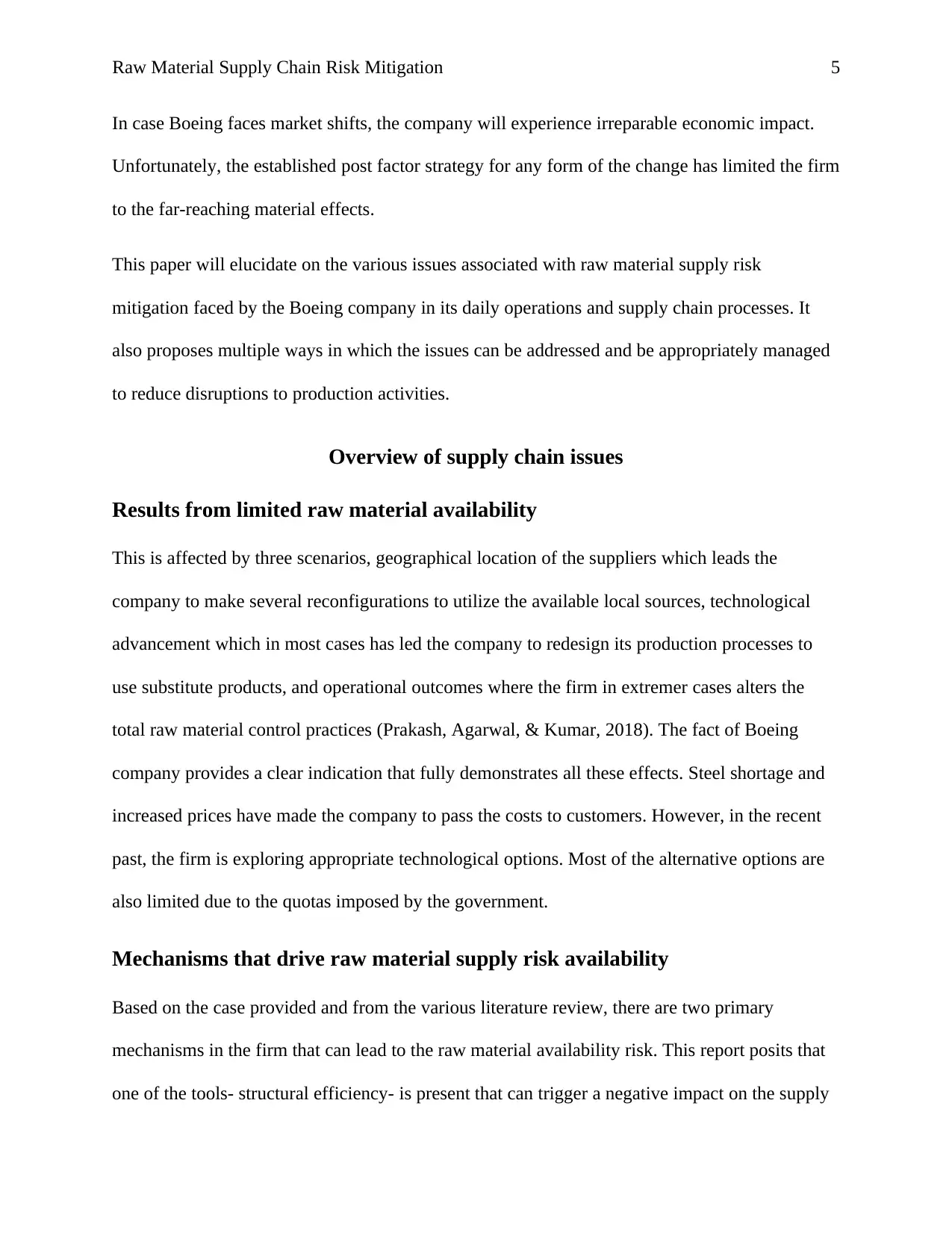
Raw Material Supply Chain Risk Mitigation 5
In case Boeing faces market shifts, the company will experience irreparable economic impact.
Unfortunately, the established post factor strategy for any form of the change has limited the firm
to the far-reaching material effects.
This paper will elucidate on the various issues associated with raw material supply risk
mitigation faced by the Boeing company in its daily operations and supply chain processes. It
also proposes multiple ways in which the issues can be addressed and be appropriately managed
to reduce disruptions to production activities.
Overview of supply chain issues
Results from limited raw material availability
This is affected by three scenarios, geographical location of the suppliers which leads the
company to make several reconfigurations to utilize the available local sources, technological
advancement which in most cases has led the company to redesign its production processes to
use substitute products, and operational outcomes where the firm in extremer cases alters the
total raw material control practices (Prakash, Agarwal, & Kumar, 2018). The fact of Boeing
company provides a clear indication that fully demonstrates all these effects. Steel shortage and
increased prices have made the company to pass the costs to customers. However, in the recent
past, the firm is exploring appropriate technological options. Most of the alternative options are
also limited due to the quotas imposed by the government.
Mechanisms that drive raw material supply risk availability
Based on the case provided and from the various literature review, there are two primary
mechanisms in the firm that can lead to the raw material availability risk. This report posits that
one of the tools- structural efficiency- is present that can trigger a negative impact on the supply
In case Boeing faces market shifts, the company will experience irreparable economic impact.
Unfortunately, the established post factor strategy for any form of the change has limited the firm
to the far-reaching material effects.
This paper will elucidate on the various issues associated with raw material supply risk
mitigation faced by the Boeing company in its daily operations and supply chain processes. It
also proposes multiple ways in which the issues can be addressed and be appropriately managed
to reduce disruptions to production activities.
Overview of supply chain issues
Results from limited raw material availability
This is affected by three scenarios, geographical location of the suppliers which leads the
company to make several reconfigurations to utilize the available local sources, technological
advancement which in most cases has led the company to redesign its production processes to
use substitute products, and operational outcomes where the firm in extremer cases alters the
total raw material control practices (Prakash, Agarwal, & Kumar, 2018). The fact of Boeing
company provides a clear indication that fully demonstrates all these effects. Steel shortage and
increased prices have made the company to pass the costs to customers. However, in the recent
past, the firm is exploring appropriate technological options. Most of the alternative options are
also limited due to the quotas imposed by the government.
Mechanisms that drive raw material supply risk availability
Based on the case provided and from the various literature review, there are two primary
mechanisms in the firm that can lead to the raw material availability risk. This report posits that
one of the tools- structural efficiency- is present that can trigger a negative impact on the supply
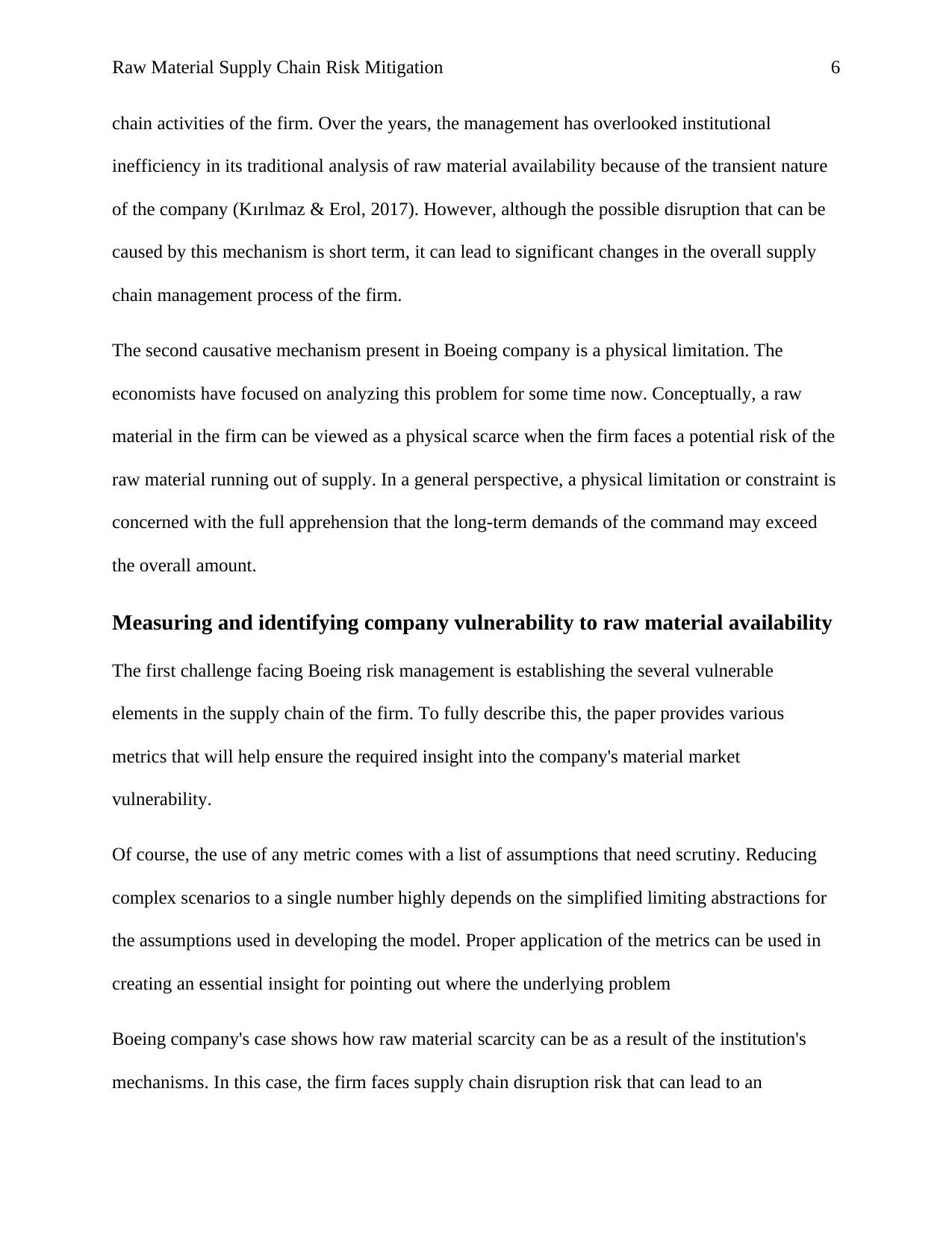
Raw Material Supply Chain Risk Mitigation 6
chain activities of the firm. Over the years, the management has overlooked institutional
inefficiency in its traditional analysis of raw material availability because of the transient nature
of the company (Kırılmaz & Erol, 2017). However, although the possible disruption that can be
caused by this mechanism is short term, it can lead to significant changes in the overall supply
chain management process of the firm.
The second causative mechanism present in Boeing company is a physical limitation. The
economists have focused on analyzing this problem for some time now. Conceptually, a raw
material in the firm can be viewed as a physical scarce when the firm faces a potential risk of the
raw material running out of supply. In a general perspective, a physical limitation or constraint is
concerned with the full apprehension that the long-term demands of the command may exceed
the overall amount.
Measuring and identifying company vulnerability to raw material availability
The first challenge facing Boeing risk management is establishing the several vulnerable
elements in the supply chain of the firm. To fully describe this, the paper provides various
metrics that will help ensure the required insight into the company's material market
vulnerability.
Of course, the use of any metric comes with a list of assumptions that need scrutiny. Reducing
complex scenarios to a single number highly depends on the simplified limiting abstractions for
the assumptions used in developing the model. Proper application of the metrics can be used in
creating an essential insight for pointing out where the underlying problem
Boeing company's case shows how raw material scarcity can be as a result of the institution's
mechanisms. In this case, the firm faces supply chain disruption risk that can lead to an
chain activities of the firm. Over the years, the management has overlooked institutional
inefficiency in its traditional analysis of raw material availability because of the transient nature
of the company (Kırılmaz & Erol, 2017). However, although the possible disruption that can be
caused by this mechanism is short term, it can lead to significant changes in the overall supply
chain management process of the firm.
The second causative mechanism present in Boeing company is a physical limitation. The
economists have focused on analyzing this problem for some time now. Conceptually, a raw
material in the firm can be viewed as a physical scarce when the firm faces a potential risk of the
raw material running out of supply. In a general perspective, a physical limitation or constraint is
concerned with the full apprehension that the long-term demands of the command may exceed
the overall amount.
Measuring and identifying company vulnerability to raw material availability
The first challenge facing Boeing risk management is establishing the several vulnerable
elements in the supply chain of the firm. To fully describe this, the paper provides various
metrics that will help ensure the required insight into the company's material market
vulnerability.
Of course, the use of any metric comes with a list of assumptions that need scrutiny. Reducing
complex scenarios to a single number highly depends on the simplified limiting abstractions for
the assumptions used in developing the model. Proper application of the metrics can be used in
creating an essential insight for pointing out where the underlying problem
Boeing company's case shows how raw material scarcity can be as a result of the institution's
mechanisms. In this case, the firm faces supply chain disruption risk that can lead to an
⊘ This is a preview!⊘
Do you want full access?
Subscribe today to unlock all pages.

Trusted by 1+ million students worldwide

Raw Material Supply Chain Risk Mitigation 7
imbalance of production processes in the whole organization. In this case, the risk the firm is
facing is rising from the physical constraint son, the physical raw materials which occur with the
extraction of results in the overall and complete resource exhaustion.
As the case study illustrates, short term issues in the minor supply chain activities can disrupt the
production process in the whole organization. To solve this, the management should consider all
implications of the disruption and avoid the current situation where it is entirely reacting to the
post-facto supply chain disruptions.
Current Problems
Currently, the firm is increasing the levels of raw material and finished goods as a way of
mitigating the risks. Despite the tactic helping in mitigating the impact the company experience
in raw material supply disruption, it is not effective in reducing supply chain risks which are
associated with material supply. Increase in the volume of raw material levels exacerbates other
risks which include financial risk the company may face. Therefore, Boeing requires a more
aggressive and practical approach to inadequately managing its raw materials supply chain risks.
The problem with the current strategies adopted by the company is that they are general and
simplistic and to some extent, they are not realistically feasible. A more simplified approach is
required, which can help in risk identification by assigning various risks with subjective values.
The result of this general and straightforward risk management approach is discriminative, and it
is not ideal to use in making a conclusive decision in managing raw material supply chain risks.
Some of the current strategies suggest that the company maps all the suppliers, track the raw
materials in the supply chain channel to their source and have a clear understanding of all supply
processes used by the raw material suppliers.
imbalance of production processes in the whole organization. In this case, the risk the firm is
facing is rising from the physical constraint son, the physical raw materials which occur with the
extraction of results in the overall and complete resource exhaustion.
As the case study illustrates, short term issues in the minor supply chain activities can disrupt the
production process in the whole organization. To solve this, the management should consider all
implications of the disruption and avoid the current situation where it is entirely reacting to the
post-facto supply chain disruptions.
Current Problems
Currently, the firm is increasing the levels of raw material and finished goods as a way of
mitigating the risks. Despite the tactic helping in mitigating the impact the company experience
in raw material supply disruption, it is not effective in reducing supply chain risks which are
associated with material supply. Increase in the volume of raw material levels exacerbates other
risks which include financial risk the company may face. Therefore, Boeing requires a more
aggressive and practical approach to inadequately managing its raw materials supply chain risks.
The problem with the current strategies adopted by the company is that they are general and
simplistic and to some extent, they are not realistically feasible. A more simplified approach is
required, which can help in risk identification by assigning various risks with subjective values.
The result of this general and straightforward risk management approach is discriminative, and it
is not ideal to use in making a conclusive decision in managing raw material supply chain risks.
Some of the current strategies suggest that the company maps all the suppliers, track the raw
materials in the supply chain channel to their source and have a clear understanding of all supply
processes used by the raw material suppliers.
Paraphrase This Document
Need a fresh take? Get an instant paraphrase of this document with our AI Paraphraser

Raw Material Supply Chain Risk Mitigation 8
What is required in the firm is a risk management strategy that will allow the management to
make sound financial decisions pragmatically.an approach that will help the management in
measuring and prioritizing various risks associated with raw material sourcing? Thus, a SMART
risk management approach is required in managing the facility, people and material involved.
Specific risk management. Company risks should be categorized into two groups, the risk in one
group and the potential impact an organization faces in case of its occurrence. The effect will
provide information on what will happen in case the event takes place. Therefore, this will lead
to risk prioritization and the required resources, including people, are assigned responsibilities in
managing the risk.
Measurable- the management needs to quantify the risks and their impact on the organization.
Absolute measures are not effective in risk quantification and impact measurement. Various risks
and the potential impact can be measured in the following ways; risk data definition, collect the
required data, normalize the availed data and calculate the potential risk and its effects. Once the
risks and the impacts have been quantified, they can be translated into a risk and impact score.
Actionable- definition of the appropriate risk mitigation strategies. After identifying and
prioritizing the raw materials required in the production process, the management can now
outline specific risk mitigation approaches for each risk
Realistic- it is essential to understand the resource constraint experienced in risk management
approach. The administration can make a trade-off in the risk management strategy. Ant
management strategy needs a realistic execution plan coupled with assurances on the availability
of the required resources and personnel. In case of mitigation process being initiated, these
resources and people can be used in addressing the mitigation requirement.
What is required in the firm is a risk management strategy that will allow the management to
make sound financial decisions pragmatically.an approach that will help the management in
measuring and prioritizing various risks associated with raw material sourcing? Thus, a SMART
risk management approach is required in managing the facility, people and material involved.
Specific risk management. Company risks should be categorized into two groups, the risk in one
group and the potential impact an organization faces in case of its occurrence. The effect will
provide information on what will happen in case the event takes place. Therefore, this will lead
to risk prioritization and the required resources, including people, are assigned responsibilities in
managing the risk.
Measurable- the management needs to quantify the risks and their impact on the organization.
Absolute measures are not effective in risk quantification and impact measurement. Various risks
and the potential impact can be measured in the following ways; risk data definition, collect the
required data, normalize the availed data and calculate the potential risk and its effects. Once the
risks and the impacts have been quantified, they can be translated into a risk and impact score.
Actionable- definition of the appropriate risk mitigation strategies. After identifying and
prioritizing the raw materials required in the production process, the management can now
outline specific risk mitigation approaches for each risk
Realistic- it is essential to understand the resource constraint experienced in risk management
approach. The administration can make a trade-off in the risk management strategy. Ant
management strategy needs a realistic execution plan coupled with assurances on the availability
of the required resources and personnel. In case of mitigation process being initiated, these
resources and people can be used in addressing the mitigation requirement.
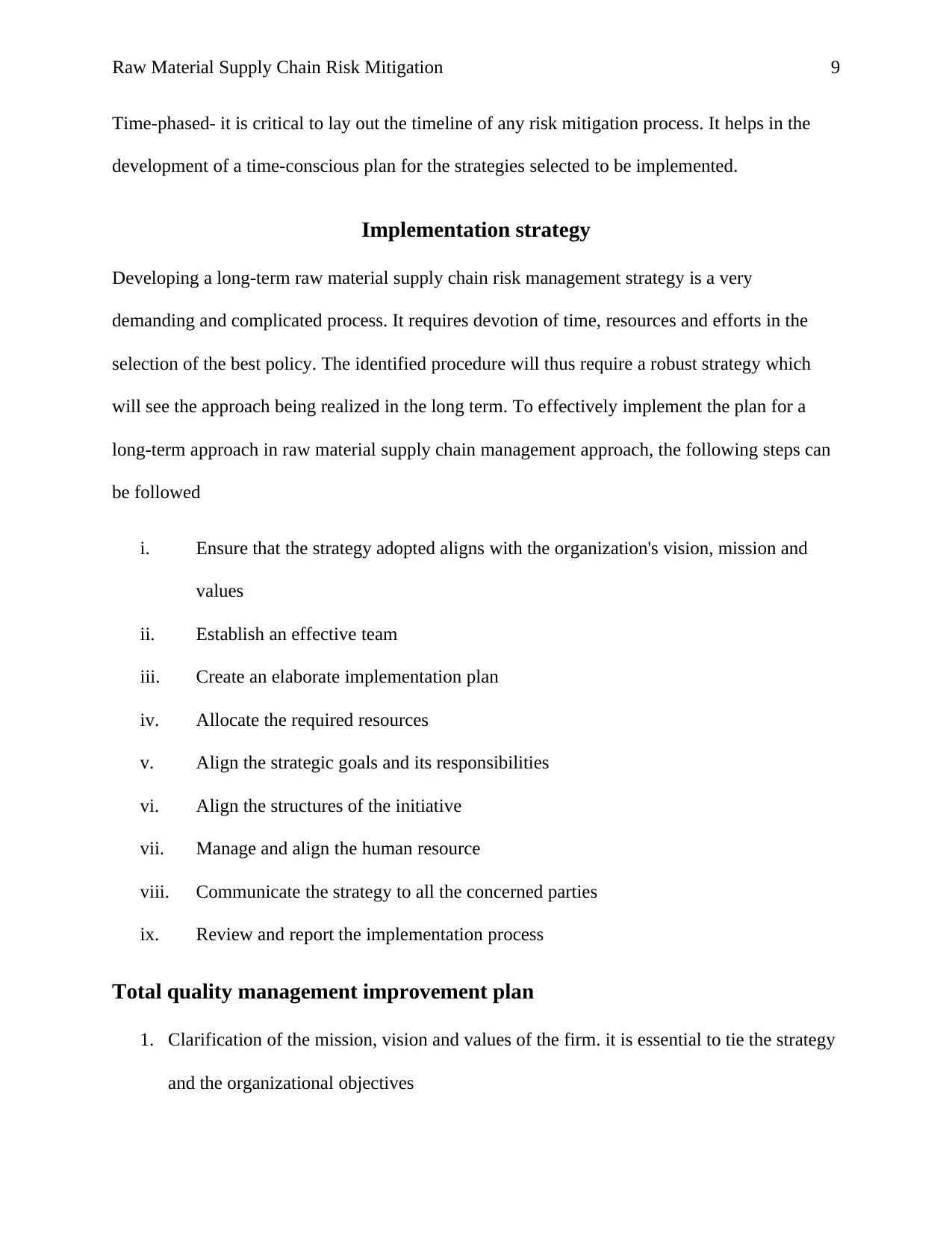
Raw Material Supply Chain Risk Mitigation 9
Time-phased- it is critical to lay out the timeline of any risk mitigation process. It helps in the
development of a time-conscious plan for the strategies selected to be implemented.
Implementation strategy
Developing a long-term raw material supply chain risk management strategy is a very
demanding and complicated process. It requires devotion of time, resources and efforts in the
selection of the best policy. The identified procedure will thus require a robust strategy which
will see the approach being realized in the long term. To effectively implement the plan for a
long-term approach in raw material supply chain management approach, the following steps can
be followed
i. Ensure that the strategy adopted aligns with the organization's vision, mission and
values
ii. Establish an effective team
iii. Create an elaborate implementation plan
iv. Allocate the required resources
v. Align the strategic goals and its responsibilities
vi. Align the structures of the initiative
vii. Manage and align the human resource
viii. Communicate the strategy to all the concerned parties
ix. Review and report the implementation process
Total quality management improvement plan
1. Clarification of the mission, vision and values of the firm. it is essential to tie the strategy
and the organizational objectives
Time-phased- it is critical to lay out the timeline of any risk mitigation process. It helps in the
development of a time-conscious plan for the strategies selected to be implemented.
Implementation strategy
Developing a long-term raw material supply chain risk management strategy is a very
demanding and complicated process. It requires devotion of time, resources and efforts in the
selection of the best policy. The identified procedure will thus require a robust strategy which
will see the approach being realized in the long term. To effectively implement the plan for a
long-term approach in raw material supply chain management approach, the following steps can
be followed
i. Ensure that the strategy adopted aligns with the organization's vision, mission and
values
ii. Establish an effective team
iii. Create an elaborate implementation plan
iv. Allocate the required resources
v. Align the strategic goals and its responsibilities
vi. Align the structures of the initiative
vii. Manage and align the human resource
viii. Communicate the strategy to all the concerned parties
ix. Review and report the implementation process
Total quality management improvement plan
1. Clarification of the mission, vision and values of the firm. it is essential to tie the strategy
and the organizational objectives
⊘ This is a preview!⊘
Do you want full access?
Subscribe today to unlock all pages.

Trusted by 1+ million students worldwide
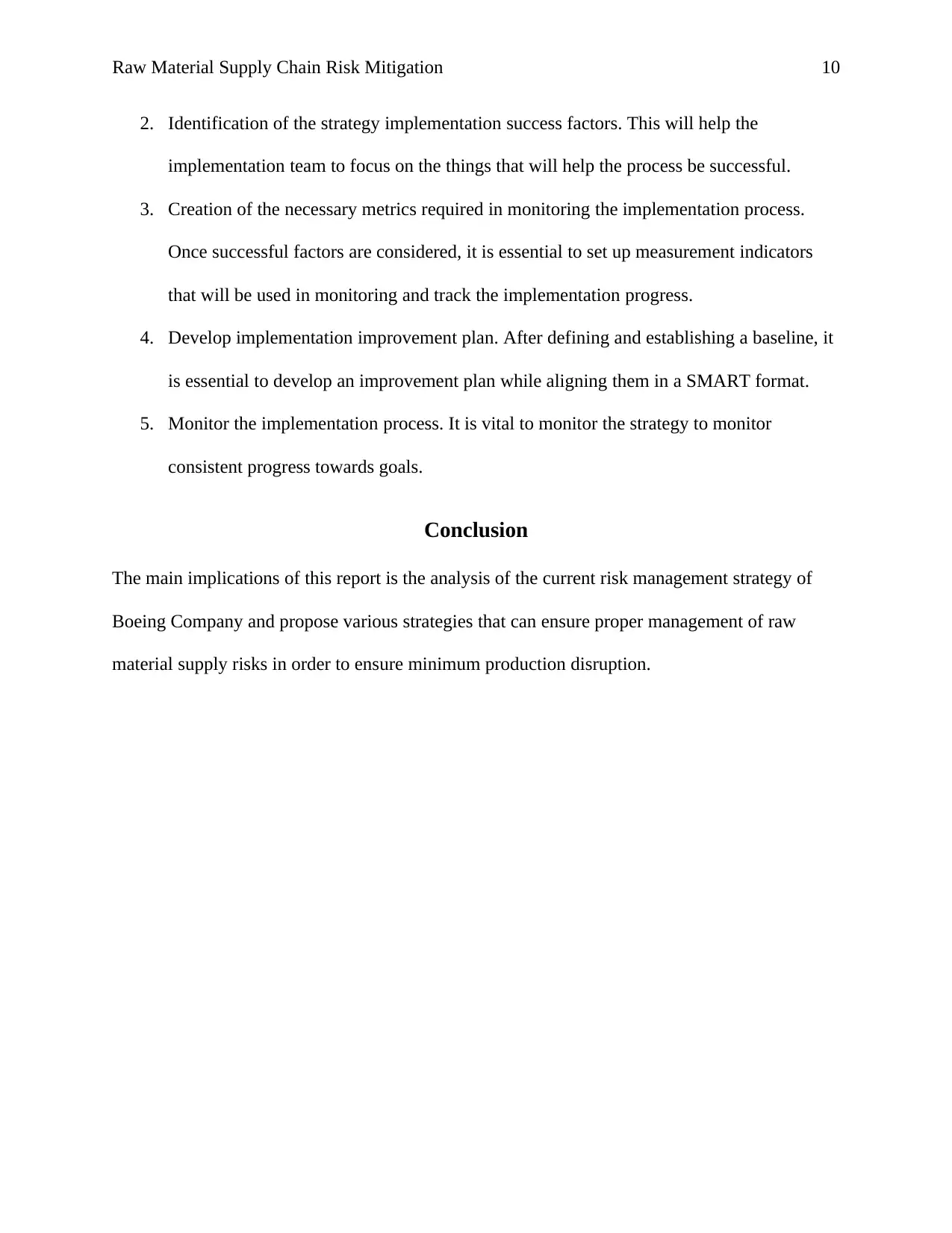
Raw Material Supply Chain Risk Mitigation 10
2. Identification of the strategy implementation success factors. This will help the
implementation team to focus on the things that will help the process be successful.
3. Creation of the necessary metrics required in monitoring the implementation process.
Once successful factors are considered, it is essential to set up measurement indicators
that will be used in monitoring and track the implementation progress.
4. Develop implementation improvement plan. After defining and establishing a baseline, it
is essential to develop an improvement plan while aligning them in a SMART format.
5. Monitor the implementation process. It is vital to monitor the strategy to monitor
consistent progress towards goals.
Conclusion
The main implications of this report is the analysis of the current risk management strategy of
Boeing Company and propose various strategies that can ensure proper management of raw
material supply risks in order to ensure minimum production disruption.
2. Identification of the strategy implementation success factors. This will help the
implementation team to focus on the things that will help the process be successful.
3. Creation of the necessary metrics required in monitoring the implementation process.
Once successful factors are considered, it is essential to set up measurement indicators
that will be used in monitoring and track the implementation progress.
4. Develop implementation improvement plan. After defining and establishing a baseline, it
is essential to develop an improvement plan while aligning them in a SMART format.
5. Monitor the implementation process. It is vital to monitor the strategy to monitor
consistent progress towards goals.
Conclusion
The main implications of this report is the analysis of the current risk management strategy of
Boeing Company and propose various strategies that can ensure proper management of raw
material supply risks in order to ensure minimum production disruption.
Paraphrase This Document
Need a fresh take? Get an instant paraphrase of this document with our AI Paraphraser
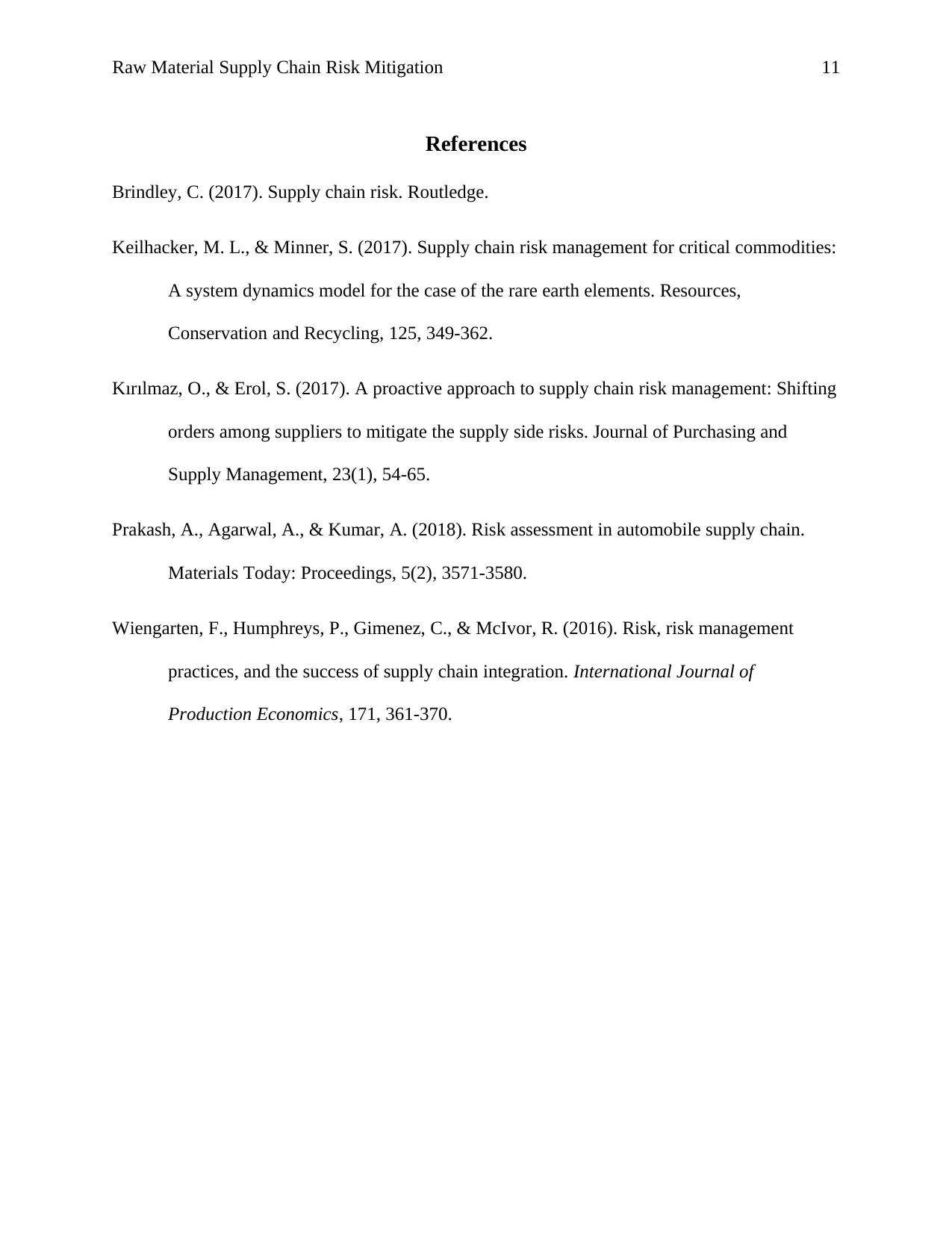
Raw Material Supply Chain Risk Mitigation 11
References
Brindley, C. (2017). Supply chain risk. Routledge.
Keilhacker, M. L., & Minner, S. (2017). Supply chain risk management for critical commodities:
A system dynamics model for the case of the rare earth elements. Resources,
Conservation and Recycling, 125, 349-362.
Kırılmaz, O., & Erol, S. (2017). A proactive approach to supply chain risk management: Shifting
orders among suppliers to mitigate the supply side risks. Journal of Purchasing and
Supply Management, 23(1), 54-65.
Prakash, A., Agarwal, A., & Kumar, A. (2018). Risk assessment in automobile supply chain.
Materials Today: Proceedings, 5(2), 3571-3580.
Wiengarten, F., Humphreys, P., Gimenez, C., & McIvor, R. (2016). Risk, risk management
practices, and the success of supply chain integration. International Journal of
Production Economics, 171, 361-370.
References
Brindley, C. (2017). Supply chain risk. Routledge.
Keilhacker, M. L., & Minner, S. (2017). Supply chain risk management for critical commodities:
A system dynamics model for the case of the rare earth elements. Resources,
Conservation and Recycling, 125, 349-362.
Kırılmaz, O., & Erol, S. (2017). A proactive approach to supply chain risk management: Shifting
orders among suppliers to mitigate the supply side risks. Journal of Purchasing and
Supply Management, 23(1), 54-65.
Prakash, A., Agarwal, A., & Kumar, A. (2018). Risk assessment in automobile supply chain.
Materials Today: Proceedings, 5(2), 3571-3580.
Wiengarten, F., Humphreys, P., Gimenez, C., & McIvor, R. (2016). Risk, risk management
practices, and the success of supply chain integration. International Journal of
Production Economics, 171, 361-370.
1 out of 11
Related Documents
Your All-in-One AI-Powered Toolkit for Academic Success.
+13062052269
info@desklib.com
Available 24*7 on WhatsApp / Email
![[object Object]](/_next/static/media/star-bottom.7253800d.svg)
Unlock your academic potential
Copyright © 2020–2025 A2Z Services. All Rights Reserved. Developed and managed by ZUCOL.





